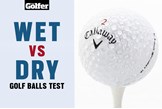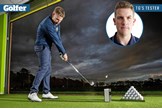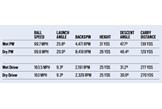TESTED: Does moisture affect a golf ball’s performance?
Published: Last updated:
How much of an impact does water have on the performance of your golf ball? With damp conditions far more common during the months of winter golf, we tested wet and dry golf balls head-to-head to find out exactly what difference a bit of moisture could make to your game.
We’ve all played on cold, wet and frosty mornings. The sort of mornings where trousers get muddy and socks get damp, when there’s just no way of your golf ball avoiding the moisture that lies on every blade of the golf course’s grass.
Many of us have practised or been fitted at a driving range where the golf balls come straight out of the ball washer and still have a damp layer coating their cover, too.
But have you ever stopped to think what impact that moisture on the golf ball has on your driver, iron and wedge shots?
RELATED: Best Waterproof Golf Shoes
Unsurprisingly, Bryson DeChambeau has. At the 2018 Tour Championship at East Lake, DeChambeau was seen spraying his Bridgestone golf balls with water on the driving range in a bid to replicate morning dew and course moisture before using a launch monitor to hit both the wet and balls and record how the performance differed.
Looking at the results from our test, the big-hitting US Open champion was certainly on to something and it’s time to factor moisture on the golf ball into our on-course decision-making as it can make a dramatic difference to how it performs.
Meet our Wet vs Dry Golf Balls tester
TG Test Pro Neil Wain (below) is a highly-experience PGA Professional based at Keele Golf Centre in Staffordshire. For added consistency we work with Neil on all of our golf club and ball tests.
RELATED: Revealed – The best golf ball for your game
WATCH: Wet vs Dry Golf Ball video
How we performed our Wet vs Dry Golf Balls test
We asked Neil to hit shots with his driver, 7-iron and pitching wedge, all with the same make and model of golf ball on the Foresight GC Quad launch monitor.
During the wet golf ball testing session we sprayed each ball several times before it was hit. During the dry golf ball testing session, each ball was thoroughly dried with a golf towel before being hit.
RELATED: Best Waterproof Golf Jackets
What our Wet vs Dry Golf Balls test revealed
Not many golfers tee up with a wet ball, as it’s usually been in your hand or pocket. But if you’re chipping on the tee as you wait, or happen to drop the ball before you tee it up, you’re likely to see a drop in backspin (or certainly backspin predictability between shots) by up to 6%.
That might not sound too dramatic, but a drop in backspin means a rise in carry, and our pro gained seven yards (or 2.6%) with a wet ball. But before you start rolling yours in the grass before teeing off, just remember that any moisture on ball or club face leads to less predictability and reduced consistency.
RELATED: Tested – Best Premium Golf Balls
And while a drop in backspin is good with a driver, it certainly isn’t with a wedge. Incredibly, we saw a drop in backspin of 88.3% with a wet wedge ball (the launch angle was also 23% higher, as shots skid up the face uncontrollably), which obviously has a massive impact on how shots stop, or don’t in this case, when they hit a green.
You may ask ‘what control do I have over hitting a wet golf ball on the course?’ Well, if your course has winter rules where you can lift, clean and replace the ball, it’s well worth drying your ball, too.
And if you use a ball washer between a green and the next tee, make sure you dry it thoroughly, especially if the next hole is a par 3.]
RELATED: Best Winter Golf Balls
Wet vs Dry Golf Balls test: The statistics

READ NEXT: TESTED: How does cold weather impact your golf balls’ performance?



